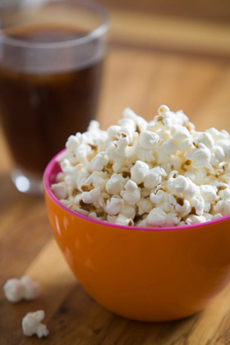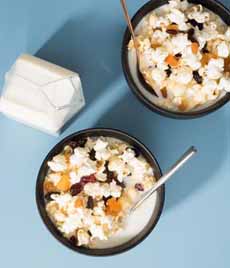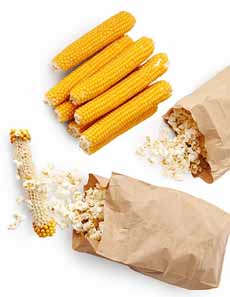

An ancient snack still popular thousands of years later. Photo by Maxwell Attenborough | IST.
|
MELODY LAN is a member of THE NIBBLE editorial staff. |
|
July 2006
Last Updated October 2018
|
 |
The History Of Popcorn
Page 1: The Early History Of Popcorn, The Indigenous Snack Of the Americas
CAPSULE REPORT: This is Page 1 of a four-page article on the history of popcorn, up through modern popcorn flavors and recipes. Click on the black links below to visit other pages.
Overview
Indigenous to Mesoamerica, popcorn is now a popular snack food all over the world. In the U.S., approximately 17.3 billion quarts of popcorn are consumed each year. Sweet-and salty kettle corn is the category’s fastest-growing flavor.
As one of America’s indigenous snack foods, popcorn has always been a part of our lives. It’s not only a household snack but it’s ubiquitous in recreation—at amusement parks, circuses, fairs, sporting events, and at every movie theatre. It’s hard to imagine a time and occasion when we don’t have the crunchy popped kernels to munch on.
Origin Of Our Favorite Popped Snack
The oldest popcorn known to date was discovered in 1948 by anthropologist Herbert Dick and botanist Earle Smith in the “Bat Cave” in west central New Mexico. The popcorn ears, which ranged from 1/2 inch to 2 inches long, are carbon-dated to be more than 5,600 years old.
Archaeologists deduce that popcorn was first made by throwing corn kernels on sizzling hot stones tended over a campfire, or onto heated sand, causing the kernels to pop.
It was not eaten as a snack food: The corn was sifted and then pounded into a fine, powdery meal and mixed with water.
This same cooking technique was used by the early Colonists, who mixed ground popcorn with milk and ate it for breakfast as a kind of cereal.
A fourth century C.E. Zapotec funeral urn found in Mexico depicts a maize god with symbols representing primitive popcorn in his headdress.
|
|

A bowl of popcorn for breakfast, with milk an, raisins and dried cranberries (photo couresy Popcorn Board). |
Ancient popcorn poppers, shallow vessels with a hole on the top and a single handle, have been found on the northern coast of Peru and date back to about 300 C.E. Peruvian Indians called the popcorn pisancalla.
A 1,000 year old popped kernel of popcorn was found in a dry cave inhabited by predecessors of the Pueblo Indian in southwest Utah. Native Americans flavored popcorn with herbs and spices.
Popcorn Reaches Europeans
Popcorn was introduced to Europeans via exploration of the New World.
Spanish explorer Hernando Cortes first learned of it during his 1519 of what is now Mexico.
He cataloged in his travel journals that the Aztecs used the popped corn, or momochitl, as decoration for ceremonial wreaths, necklaces and ornaments on the statues of their gods.
A few decades earlier, in the late 15th century, Christopher Columbus had also noted that the Native Americans made popcorn corsages and headdresses for dance rituals.
They sold them as mementos to his crew!
|
|

Popping corn can be popped in the microwave (photo courtesy Uncommon Goods). |
Around 1612, French explorers in the Great Lakes region documented use of popcorn by the Iroquois Indians, who popped corn in pottery using hot sand.
The pot filled with sand was placed over a campfire, and the kernels were mixed in to pop. The explorers also reported that during an Iroquois dinner, popcorn soup and popcorn beer were consumed.

|




